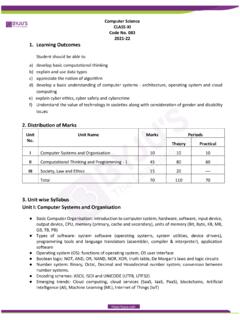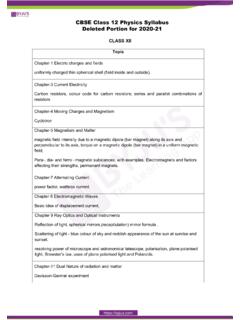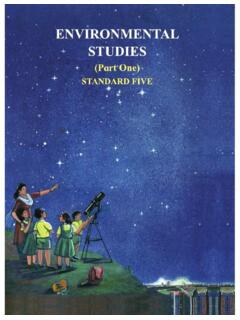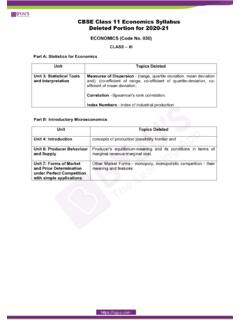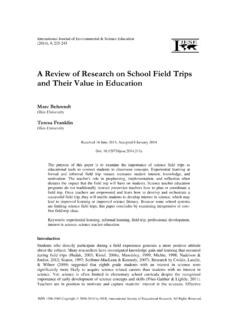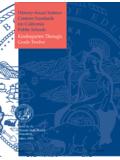Transcription of CBSE Class 10 Science Chapter 10 Light Reflection and ...
1 CBSE Class 10 Science Chapter 10 Light Reflection and Refraction Notes Visible Light or Light is an electromagnetic radiation found on the electromagnetic spectrum which enables us to see Light . Objects reflect some colours of the spectrum when Light falls on them. Learn in detail about Light and discover other interesting concepts by exploring Class 10 notes for Chapter 10 Light - Reflection and Refraction. Topics Covered In Chapter 10 Light - Reflection And Refraction: Reflection Of Light Spherical Mirrors Image Formation By Spherical Mirrors Representation Of Images Formed By Spherical Mirrors Using Ray Diagrams Sign Convention For Reflection By Spherical Mirrors Mirror Formula And Magnification Refraction Of Light Refraction Through A Rectangular Glass Slab The Refractive Index Refraction By Spherical Lenses Image Formation By Lenses Image Formation In Lenses Using Ray Diagrams Sign Convention For Spherical Lenses Lens Formula And Magnification Power Of A Lens Introduction To The Chapter What is Light ?
2 Light can be simply defined as the form of energy which helps us to see objects in dark. There are both natural and artificial sources of Light . Sunlight is the best example for the natural sources of Light . Reflection and refraction of Light are the two main properties of Light . Some common phenomena associated with lights are image formation by mirrors, the twinkling of stars, the beautiful colours of the rainbow, bending of Light by a medium and so on. CBSE Class 10 Science Chapter 10 Light Reflection and Refraction Notes Properties Of Light An electromagnetic wave so does not require any medium to travel Light tends to travel in a straight line Light has dual nature , wave as well as particle Light casts shadow Speed of Light is maximum in vacuum.
3 Its value is 3 x 108 m/s When Light falls on a surface, the following happens - Reflection - Refraction - Absorption What is Reflection of Light ? The natural phenomenon of bouncing back the Light in the same medium on striking the surface of an object is termed as the Reflection of Light . According to the laws of Reflection : The angle of Reflection is always equal to the angle of incidence. All the three rays- incident, reflected ray and the normal lie in the same plane. Virtual and Real Image Image is a point where at least two Light rays actually meet or appear to meet. Real Image Virtual Image Formed when Light rays actually meet Formed when Light rays appear to meet Can be obtained on the screen Cannot be obtained on the screen inverted erect CBSE Class 10 Science Chapter 10 Light Reflection and Refraction Notes Example - image formed on cinema screen and formed by concave mirror Example - image formed by plane mirror or convex mirror Image Formed By Plane Mirror Characteristics of Image formed by Plane Mirror Virtual and erect Size of image is equal to the size of object Image is formed as far behind the mirror as the object is in front of it
4 Laterally inverted Lateral Inversion - the right side of the object appears left side of the image and vice-versa Application of Lateral Inversion The word AMBULANCE is written in reverse direction so that it can be read correctly in rearview mirror of vehicles going in front of it. CBSE Class 10 Science Chapter 10 Light Reflection and Refraction Notes Spherical Mirrors Mirrors whose reflecting surface is curved. There are two types of spherical mirrors, they are: Convex mirror Concave mirror Properties of Concave Mirror: Reflecting surface is curved inwards Converging mirror CBSE Class 10 Science Chapter 10 Light Reflection and Refraction Notes Properties of Convex Mirror.
5 Reflecting surface is curved outwards Diverging mirror (a) concave mirror (b) convex mirror Common Terms for Spherical Mirrors Principal axis - the line joining pole and the centre of curvature Pole (P) - the centre of the spherical mirror Aperture (MN) - it is the effective diameter of the spherical mirror Centre of curvature (C) - The centre of the hollow glass sphere of which the mirror was a part Radius of curvature (R) - The distance between the pole and the centre of curvature Focus (F) - The point of principle axis where all the parallel Light rays actually meet or appear to meet after Reflection Focal Length (f) - The distance between the pole and the focus Relationship between focal length and the radius of curvature.
6 F=R/2 Rules For Making Ray Diagrams By Spherical Mirror (i) A ray passing to the principal axis, after Reflection , will pass through the principal focus in case of a concave mirror or appear to diverge from the principal focus in case of a convex mirror CBSE Class 10 Science Chapter 10 Light Reflection and Refraction Notes (ii) A ray passing through the principal focus of a concave mirror or a ray which is directed towards the principal focus of a convex mirror, after Reflection , will emerge parallel to the principal axis (iii) A ray passing through the centre of curvature of a concave mirror or directed in the direction of the centre of curvature of a convex mirror, after Reflection , is reflected back along the same path (iv) A ray incident obliquely to the principal axis, towards a point P (pole of the mirror), on the concave mirror or a convex mirror, is reflected obliquely.
7 The incident and reflected rays follow the laws of Reflection at the point of incidence (point P), making equal angles with the principal axis CBSE Class 10 Science Chapter 10 Light Reflection and Refraction Notes Ray Diagrams For Images Formed by Concave Mirror (i) When object is at infinity Image Position - At 'F' Nature of image - Real, inverted Size - Point sized or highly diminished (ii) When object is beyond 'C' Image Position - Between 'F' and 'C' Nature of image - Real, inverted Size - Diminished (iii) When object is at 'C' Image Position - At 'C' Nature of image - Real, inverted Size - Same size as that of object CBSE Class 10 Science Chapter 10 Light Reflection and Refraction Notes (iv) When object is placed between 'F' and 'C' Image Position - Beyond 'C' Nature of image - Real, inverted Size - Enlarged (v) When object is placed at 'F' Image Position - At infinity Nature of image - Real, inverted Size - Highly enlarged (vi)
8 When object is between 'P' and 'F' Image Position - Behind the mirror CBSE Class 10 Science Chapter 10 Light Reflection and Refraction Notes Nature of image - Virtual, erect Size - Enlarged Uses of Concave Mirror Used in torches, searchlights and vehicles headlights to get powerful parallel beam of Light Concave mirrors are used by dentists to see large image of teeth of patients. (Teeth have to be placed between pole and focus) Concave mirror is used as shaving mirror to see a larger image of the face Large concave mirrors are used to concentrate sunlight to produce heat in solar furnace Ray Diagrams of Images formed by convex mirror (i) When object is at infinity Image Position - At 'F' Nature of image - Virtual, erect Size - Point sized (ii)
9 When object is placed between pole and infinity Image Position - Between 'P' and 'F' Nature of image - Virtual, erect Size Diminished CBSE Class 10 Science Chapter 10 Light Reflection and Refraction Notes A full length image of a tall buidling/tree can be seen in a small convex mirror Uses of Convex Mirror Convex mirrors are used as rear view mirrors in vehicles because - they always give an erect though diminished image - they have a wider field of view as they are curved outwards Convex mirrors are used at blind turns and on points of merging traffic to facilitate vision of both side traffic Used in shops as security mirror Sign Convention for Reflection by Spherical Mirror The object is
10 Placed to the left of the mirror All distances parallel to the principal axis are measured from the pole of the mirror All distances measured in the direction of incident ray (along + X-axis) are taken as positive and those measured against the direction of incident ray (along - X-axis) are taken as negative Distance measured perpendicular to and above the principal axis are taken as positive Distances measured perpendicular to and below the principal axis are taken as negative CBSE Class 10 Science Chapter 10 Light Reflection and Refraction Notes Object distance = 'u' is always positive Focal length of concave mirror = negative Focal length of convex mirror = positive Mirror Formula 1/v + 1/u = 1/f Where v=image distance u= object distance f=Focal length Magnification of Spherical Mirrors It is the ratio of the height of the image to the height of
